World Literature and Culture: Themes in The Death of Ivan Ilych
VerifiedAdded on 2021/11/15
|5
|1402
|42
Essay
AI Summary
This essay provides an analysis of Leo Tolstoy's 'The Death of Ivan Ilych,' exploring the significant themes present in the novella. The essay examines the contrast between Ivan's inner and outer life, highlighting his initial pursuit of societal happiness and the eventual realization of life's true nature. It delves into the themes of life and death, illustrating Ivan's contemplation of mortality and the vanity of human desires, as well as the interplay between happiness and sadness. The essay concludes by emphasizing Tolstoy's use of these themes to portray Ivan's journey and to convey insights into the human condition, including the acceptance of death. The analysis underscores the work's effectiveness in conveying the protagonist's experiences and the universality of the themes explored.
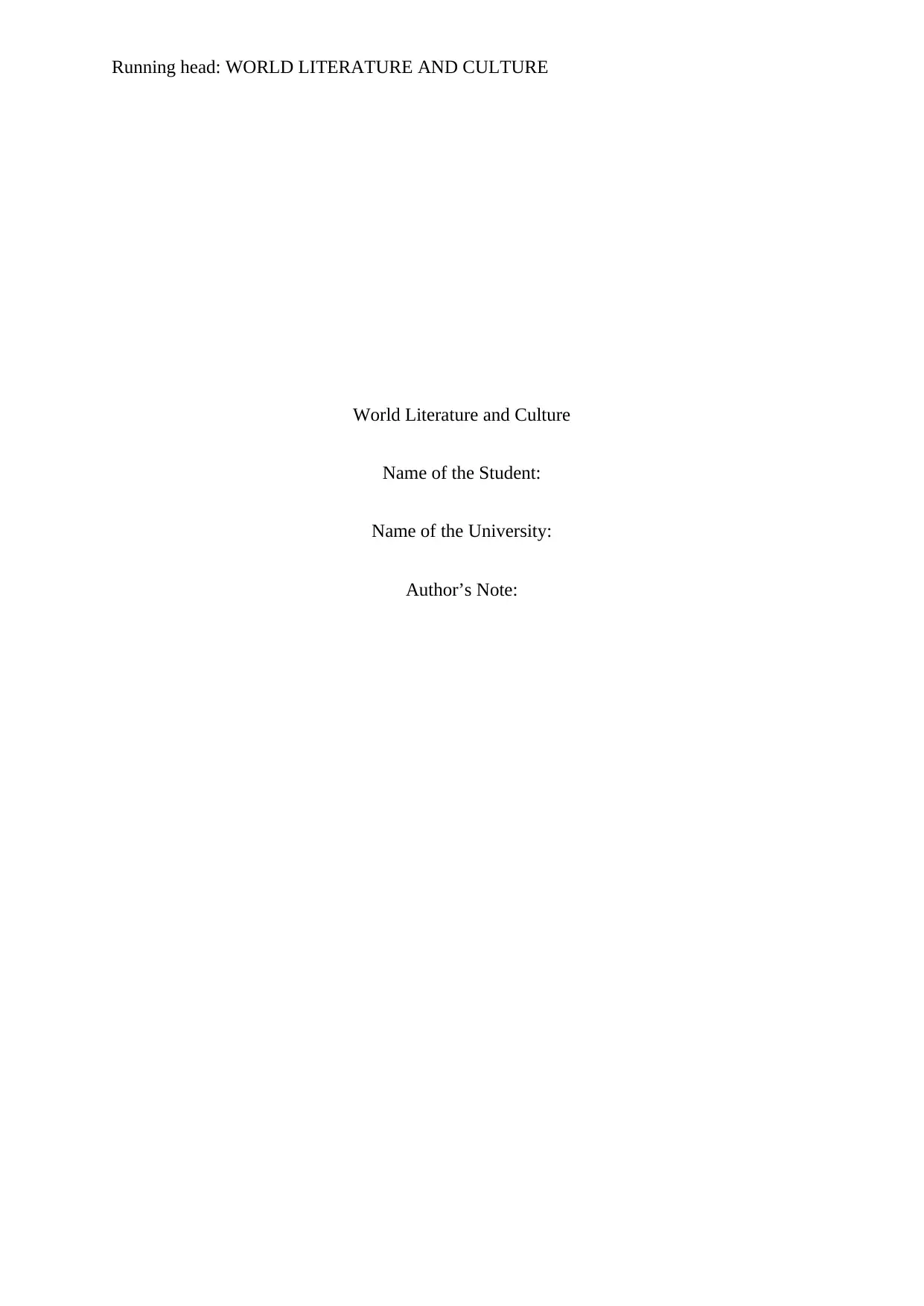
Running head: WORLD LITERATURE AND CULTURE
World Literature and Culture
Name of the Student:
Name of the University:
Author’s Note:
World Literature and Culture
Name of the Student:
Name of the University:
Author’s Note:
Paraphrase This Document
Need a fresh take? Get an instant paraphrase of this document with our AI Paraphraser
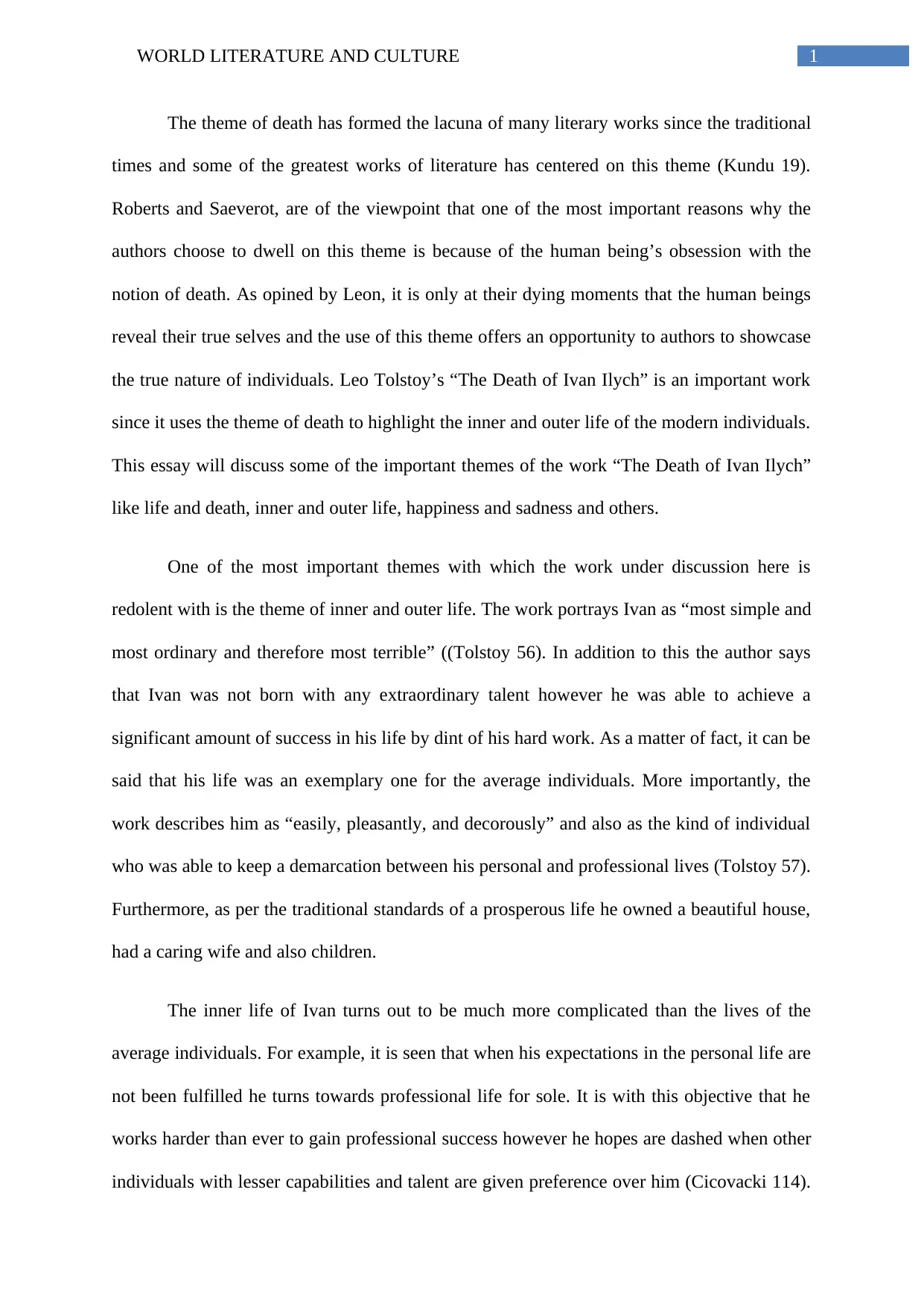
1WORLD LITERATURE AND CULTURE
The theme of death has formed the lacuna of many literary works since the traditional
times and some of the greatest works of literature has centered on this theme (Kundu 19).
Roberts and Saeverot, are of the viewpoint that one of the most important reasons why the
authors choose to dwell on this theme is because of the human being’s obsession with the
notion of death. As opined by Leon, it is only at their dying moments that the human beings
reveal their true selves and the use of this theme offers an opportunity to authors to showcase
the true nature of individuals. Leo Tolstoy’s “The Death of Ivan Ilych” is an important work
since it uses the theme of death to highlight the inner and outer life of the modern individuals.
This essay will discuss some of the important themes of the work “The Death of Ivan Ilych”
like life and death, inner and outer life, happiness and sadness and others.
One of the most important themes with which the work under discussion here is
redolent with is the theme of inner and outer life. The work portrays Ivan as “most simple and
most ordinary and therefore most terrible” ((Tolstoy 56). In addition to this the author says
that Ivan was not born with any extraordinary talent however he was able to achieve a
significant amount of success in his life by dint of his hard work. As a matter of fact, it can be
said that his life was an exemplary one for the average individuals. More importantly, the
work describes him as “easily, pleasantly, and decorously” and also as the kind of individual
who was able to keep a demarcation between his personal and professional lives (Tolstoy 57).
Furthermore, as per the traditional standards of a prosperous life he owned a beautiful house,
had a caring wife and also children.
The inner life of Ivan turns out to be much more complicated than the lives of the
average individuals. For example, it is seen that when his expectations in the personal life are
not been fulfilled he turns towards professional life for sole. It is with this objective that he
works harder than ever to gain professional success however he hopes are dashed when other
individuals with lesser capabilities and talent are given preference over him (Cicovacki 114).
The theme of death has formed the lacuna of many literary works since the traditional
times and some of the greatest works of literature has centered on this theme (Kundu 19).
Roberts and Saeverot, are of the viewpoint that one of the most important reasons why the
authors choose to dwell on this theme is because of the human being’s obsession with the
notion of death. As opined by Leon, it is only at their dying moments that the human beings
reveal their true selves and the use of this theme offers an opportunity to authors to showcase
the true nature of individuals. Leo Tolstoy’s “The Death of Ivan Ilych” is an important work
since it uses the theme of death to highlight the inner and outer life of the modern individuals.
This essay will discuss some of the important themes of the work “The Death of Ivan Ilych”
like life and death, inner and outer life, happiness and sadness and others.
One of the most important themes with which the work under discussion here is
redolent with is the theme of inner and outer life. The work portrays Ivan as “most simple and
most ordinary and therefore most terrible” ((Tolstoy 56). In addition to this the author says
that Ivan was not born with any extraordinary talent however he was able to achieve a
significant amount of success in his life by dint of his hard work. As a matter of fact, it can be
said that his life was an exemplary one for the average individuals. More importantly, the
work describes him as “easily, pleasantly, and decorously” and also as the kind of individual
who was able to keep a demarcation between his personal and professional lives (Tolstoy 57).
Furthermore, as per the traditional standards of a prosperous life he owned a beautiful house,
had a caring wife and also children.
The inner life of Ivan turns out to be much more complicated than the lives of the
average individuals. For example, it is seen that when his expectations in the personal life are
not been fulfilled he turns towards professional life for sole. It is with this objective that he
works harder than ever to gain professional success however he hopes are dashed when other
individuals with lesser capabilities and talent are given preference over him (Cicovacki 114).
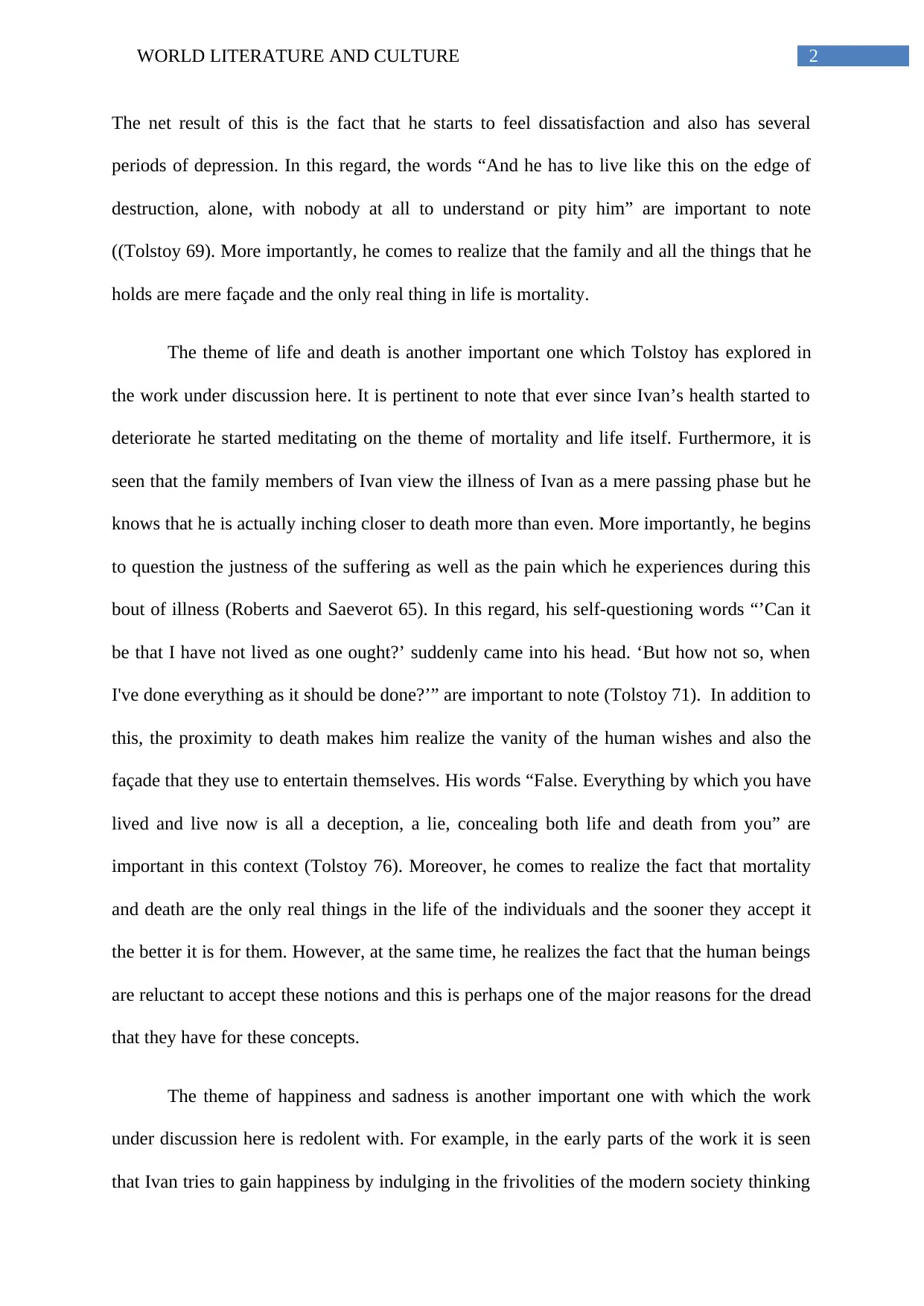
2WORLD LITERATURE AND CULTURE
The net result of this is the fact that he starts to feel dissatisfaction and also has several
periods of depression. In this regard, the words “And he has to live like this on the edge of
destruction, alone, with nobody at all to understand or pity him” are important to note
((Tolstoy 69). More importantly, he comes to realize that the family and all the things that he
holds are mere façade and the only real thing in life is mortality.
The theme of life and death is another important one which Tolstoy has explored in
the work under discussion here. It is pertinent to note that ever since Ivan’s health started to
deteriorate he started meditating on the theme of mortality and life itself. Furthermore, it is
seen that the family members of Ivan view the illness of Ivan as a mere passing phase but he
knows that he is actually inching closer to death more than even. More importantly, he begins
to question the justness of the suffering as well as the pain which he experiences during this
bout of illness (Roberts and Saeverot 65). In this regard, his self-questioning words “’Can it
be that I have not lived as one ought?’ suddenly came into his head. ‘But how not so, when
I've done everything as it should be done?’” are important to note (Tolstoy 71). In addition to
this, the proximity to death makes him realize the vanity of the human wishes and also the
façade that they use to entertain themselves. His words “False. Everything by which you have
lived and live now is all a deception, a lie, concealing both life and death from you” are
important in this context (Tolstoy 76). Moreover, he comes to realize the fact that mortality
and death are the only real things in the life of the individuals and the sooner they accept it
the better it is for them. However, at the same time, he realizes the fact that the human beings
are reluctant to accept these notions and this is perhaps one of the major reasons for the dread
that they have for these concepts.
The theme of happiness and sadness is another important one with which the work
under discussion here is redolent with. For example, in the early parts of the work it is seen
that Ivan tries to gain happiness by indulging in the frivolities of the modern society thinking
The net result of this is the fact that he starts to feel dissatisfaction and also has several
periods of depression. In this regard, the words “And he has to live like this on the edge of
destruction, alone, with nobody at all to understand or pity him” are important to note
((Tolstoy 69). More importantly, he comes to realize that the family and all the things that he
holds are mere façade and the only real thing in life is mortality.
The theme of life and death is another important one which Tolstoy has explored in
the work under discussion here. It is pertinent to note that ever since Ivan’s health started to
deteriorate he started meditating on the theme of mortality and life itself. Furthermore, it is
seen that the family members of Ivan view the illness of Ivan as a mere passing phase but he
knows that he is actually inching closer to death more than even. More importantly, he begins
to question the justness of the suffering as well as the pain which he experiences during this
bout of illness (Roberts and Saeverot 65). In this regard, his self-questioning words “’Can it
be that I have not lived as one ought?’ suddenly came into his head. ‘But how not so, when
I've done everything as it should be done?’” are important to note (Tolstoy 71). In addition to
this, the proximity to death makes him realize the vanity of the human wishes and also the
façade that they use to entertain themselves. His words “False. Everything by which you have
lived and live now is all a deception, a lie, concealing both life and death from you” are
important in this context (Tolstoy 76). Moreover, he comes to realize the fact that mortality
and death are the only real things in the life of the individuals and the sooner they accept it
the better it is for them. However, at the same time, he realizes the fact that the human beings
are reluctant to accept these notions and this is perhaps one of the major reasons for the dread
that they have for these concepts.
The theme of happiness and sadness is another important one with which the work
under discussion here is redolent with. For example, in the early parts of the work it is seen
that Ivan tries to gain happiness by indulging in the frivolities of the modern society thinking
⊘ This is a preview!⊘
Do you want full access?
Subscribe today to unlock all pages.

Trusted by 1+ million students worldwide
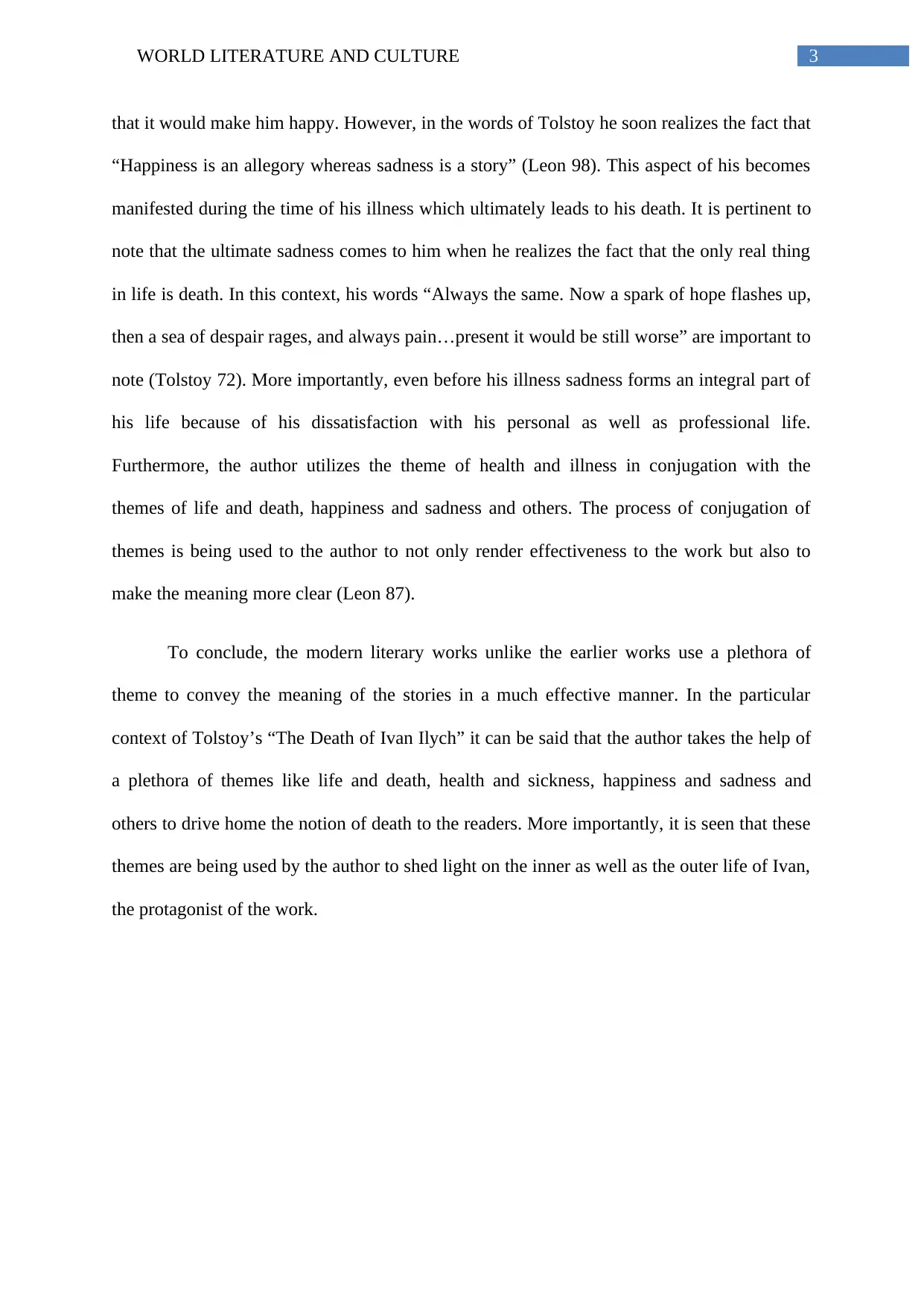
3WORLD LITERATURE AND CULTURE
that it would make him happy. However, in the words of Tolstoy he soon realizes the fact that
“Happiness is an allegory whereas sadness is a story” (Leon 98). This aspect of his becomes
manifested during the time of his illness which ultimately leads to his death. It is pertinent to
note that the ultimate sadness comes to him when he realizes the fact that the only real thing
in life is death. In this context, his words “Always the same. Now a spark of hope flashes up,
then a sea of despair rages, and always pain…present it would be still worse” are important to
note (Tolstoy 72). More importantly, even before his illness sadness forms an integral part of
his life because of his dissatisfaction with his personal as well as professional life.
Furthermore, the author utilizes the theme of health and illness in conjugation with the
themes of life and death, happiness and sadness and others. The process of conjugation of
themes is being used to the author to not only render effectiveness to the work but also to
make the meaning more clear (Leon 87).
To conclude, the modern literary works unlike the earlier works use a plethora of
theme to convey the meaning of the stories in a much effective manner. In the particular
context of Tolstoy’s “The Death of Ivan Ilych” it can be said that the author takes the help of
a plethora of themes like life and death, health and sickness, happiness and sadness and
others to drive home the notion of death to the readers. More importantly, it is seen that these
themes are being used by the author to shed light on the inner as well as the outer life of Ivan,
the protagonist of the work.
that it would make him happy. However, in the words of Tolstoy he soon realizes the fact that
“Happiness is an allegory whereas sadness is a story” (Leon 98). This aspect of his becomes
manifested during the time of his illness which ultimately leads to his death. It is pertinent to
note that the ultimate sadness comes to him when he realizes the fact that the only real thing
in life is death. In this context, his words “Always the same. Now a spark of hope flashes up,
then a sea of despair rages, and always pain…present it would be still worse” are important to
note (Tolstoy 72). More importantly, even before his illness sadness forms an integral part of
his life because of his dissatisfaction with his personal as well as professional life.
Furthermore, the author utilizes the theme of health and illness in conjugation with the
themes of life and death, happiness and sadness and others. The process of conjugation of
themes is being used to the author to not only render effectiveness to the work but also to
make the meaning more clear (Leon 87).
To conclude, the modern literary works unlike the earlier works use a plethora of
theme to convey the meaning of the stories in a much effective manner. In the particular
context of Tolstoy’s “The Death of Ivan Ilych” it can be said that the author takes the help of
a plethora of themes like life and death, health and sickness, happiness and sadness and
others to drive home the notion of death to the readers. More importantly, it is seen that these
themes are being used by the author to shed light on the inner as well as the outer life of Ivan,
the protagonist of the work.
Paraphrase This Document
Need a fresh take? Get an instant paraphrase of this document with our AI Paraphraser
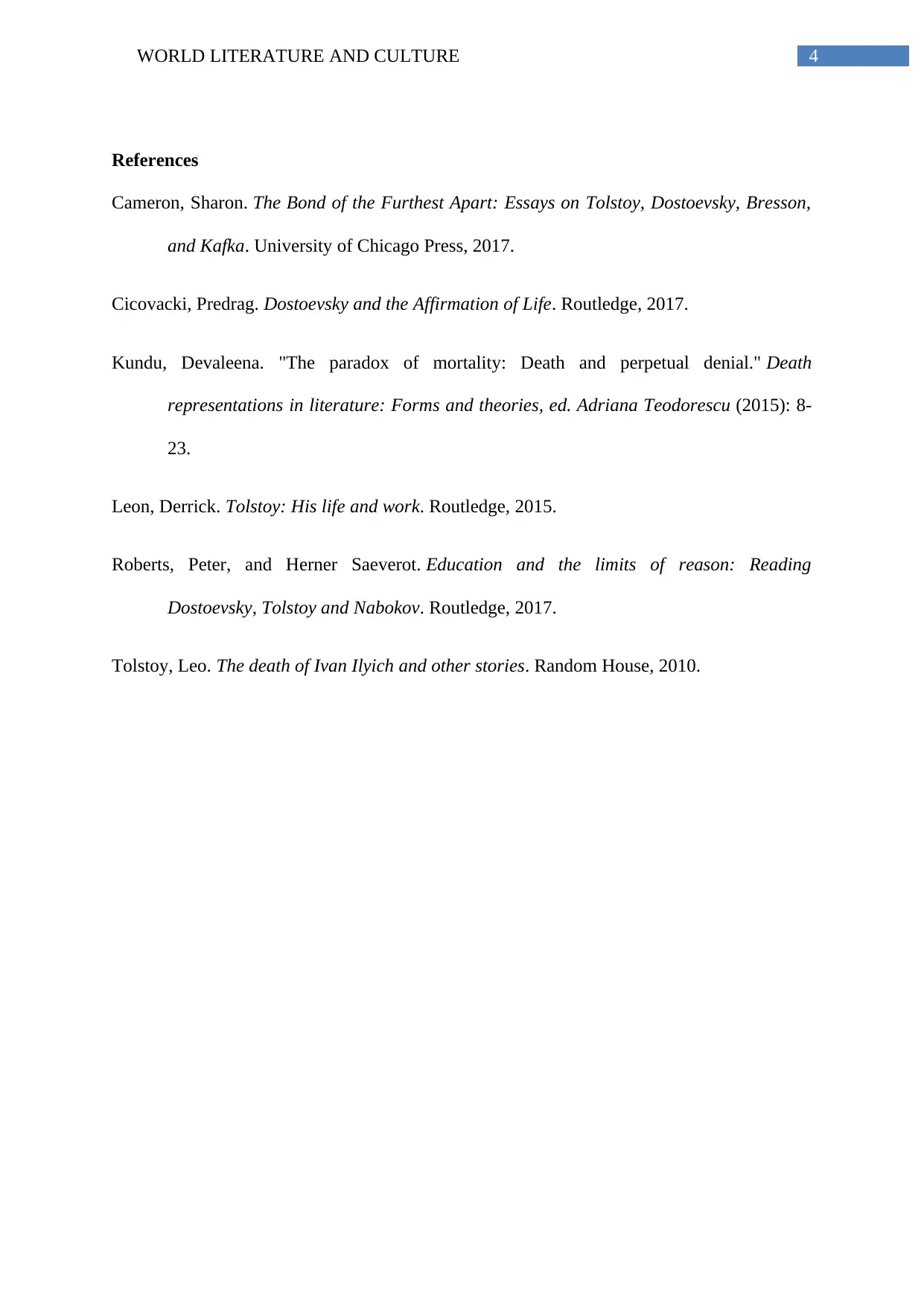
4WORLD LITERATURE AND CULTURE
References
Cameron, Sharon. The Bond of the Furthest Apart: Essays on Tolstoy, Dostoevsky, Bresson,
and Kafka. University of Chicago Press, 2017.
Cicovacki, Predrag. Dostoevsky and the Affirmation of Life. Routledge, 2017.
Kundu, Devaleena. "The paradox of mortality: Death and perpetual denial." Death
representations in literature: Forms and theories, ed. Adriana Teodorescu (2015): 8-
23.
Leon, Derrick. Tolstoy: His life and work. Routledge, 2015.
Roberts, Peter, and Herner Saeverot. Education and the limits of reason: Reading
Dostoevsky, Tolstoy and Nabokov. Routledge, 2017.
Tolstoy, Leo. The death of Ivan Ilyich and other stories. Random House, 2010.
References
Cameron, Sharon. The Bond of the Furthest Apart: Essays on Tolstoy, Dostoevsky, Bresson,
and Kafka. University of Chicago Press, 2017.
Cicovacki, Predrag. Dostoevsky and the Affirmation of Life. Routledge, 2017.
Kundu, Devaleena. "The paradox of mortality: Death and perpetual denial." Death
representations in literature: Forms and theories, ed. Adriana Teodorescu (2015): 8-
23.
Leon, Derrick. Tolstoy: His life and work. Routledge, 2015.
Roberts, Peter, and Herner Saeverot. Education and the limits of reason: Reading
Dostoevsky, Tolstoy and Nabokov. Routledge, 2017.
Tolstoy, Leo. The death of Ivan Ilyich and other stories. Random House, 2010.
1 out of 5
Related Documents
Your All-in-One AI-Powered Toolkit for Academic Success.
+13062052269
info@desklib.com
Available 24*7 on WhatsApp / Email
![[object Object]](/_next/static/media/star-bottom.7253800d.svg)
Unlock your academic potential
Copyright © 2020–2025 A2Z Services. All Rights Reserved. Developed and managed by ZUCOL.





